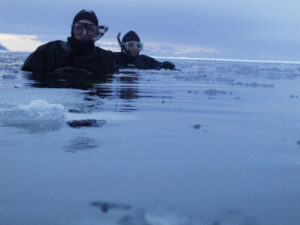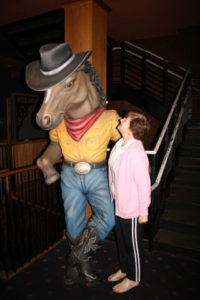



“A Florida Keys Fishy History of the Denizens of The Deep”

American Press Travel News–March 1st, The following is a short excerpt from Bob’s book: “A History of Fishing in the Florida Keys.” –From all corners of the earth, tourist visitors make pilgrimages to the Florida Keys to fish, and it’s no wonder, with more than 600 fish varieties in Florida waters, most of which are caught in the waters between Miami and the 150-miles down to Key West. And according to the writings of Zane Grey, a fabulous outdoor writer, and world famous angler, the waters between Indian Key and Bahia Honda Harbor were the very best in the world (as he wrote in the 1920’s). So, along with locals, and Americans from all over the U.S.A. who come to duel with offshore fish such as swordfish, marlin, sailfish, mackerel, tuna, wahoo, dolphin fish (Mahi Mahi), and a large assortment of other deep -sea fishes, the Keys is most noted for, it stands to reason that the real magnet drawing all to these boney islands, are these underwater finned residents of the Keys! Ask anyone about the Florida Keys, most responses would be about fishing, Key Lime pie-sort of the “apple pie & mom” of South Florida’s special nature, is what is thought of first.
Inshore, there is an entire hierarchy of fish-royalty, from the bonefish, tarpon, permit, the triage of the perfecta, to the snook, seatrout, red drum, and mangrove snapper, that today, as in the past hundred years, attract anglers to both shore, and canoe-fish as well as hiring hundreds of fishing guides and their skiffs, in pursuit of these fish for picture-trophy, and the plate as well. Today, with 43-bridges that connect each of the Keys Islands bridge fishing is also a great draw for anglers without boats, to bring their families and friends to go out to sea without ever getting their sneakers wet and still catch fish too!
Ginseng; a Health Panacea for Millions, Or Is It?
Ginseng, the “root” of all evil to several health conditions, and the real and perceived boon to assisting in various medical issues.
Many locations near woods and waters Ginseng can be found and has at least a few die-hard seekers of this profitably sold root, traipsing around in those wild places.
Today, there is so much interest in Ginseng that there are television reality shows that follow ginseng hunter’s lifestyle in their pursuit of earning big dollars sales rewards.
Ginseng today is sold in every pharmacy and drug stores in capsule, pill, tea, and oil extracts, forms. Being one of the most well-known herbs in the natural medicine world, ginseng has been in use for a long time in traditional Chinese medicine and other parts of Asia. It has also been used extensively by peoples of North America as a stimulant and treatment for various conditions.
While there are 11 different ginseng species, the term ginseng is applied to both American and Asian/ Korean ginseng. Among these the true ginseng plant comes from the Panax genus.
The active compounds in ginseng which give this plant its therapeutic properties are known as “ginsenosides.” Various ginseng species have different types and properties. As such, each type offers different health benefits with the following being some of the most prominent ones:
Ginseng offers good stress Regulation. Both American and Asian varieties of ginseng have exhibited the capacity to cope with both mental and physical stressors. Individuals who take ginseng for stress management report an increased sense of wellbeing.
This anti-stress mechanism works by controlling the adrenal glands and regulating the stress response and hormonal changes due to stress. When subject to stress, the stress hormone, cortisol, is secreted to counteract stress, and maintain homeostasis ( a good level of “calm.)” But, too much cortisol secretion can be problematic and ginseng can improve this situation by regulating its functions.

There is a long tradition of ginseng-hunting in the United States. It can even be traced from Daniel Boone, the folk hero frontiersman and locally and far more recently to John Frank Warner who was mentored during walks in the woods of the Plateau by his grandpa Warner. “Johnny” became a sort of guru in the ways of the “sain” as it was called in days of yore. He watched his Papa dry it and make medicine out of it. Today and for the past decades John Warner Herb Co. has been a go-to place for Natural Herb Products right on Highway 127 South.
Ginseng, as a medicinal herb, has become a hot energy-drink ingredient, and a trendy remedy for all sorts of maladies. Modern days; Miller, carrying his $2 ginseng-hunting permit, typically finds the leafy plant in Maryland’s Savage River State Forest on steep, shady slopes and digs up the gnarly roots with a long screwdriver.
Hunting ginseng never made anyone filthy rich, but with the plant picked to near extinction in China, where it is long revered, and with Asians prizing American ginseng’s calming properties, a pound (half a kilogram) of high-quality root can net hunters more than $1,000. However, in 2017, the value of an American pound of Ginseng was from $75 to 135 dollars per pound, based on condition of the roots.
Note* at least 15 states have banned the taking of wild ginseng due to it becoming a scarce commodity and so many people digging up private, state and federal wilderness properties. And poaching as seen on recent TV shows is a problem too!
But ginseng can be grown, and the ban affecting state land could be good news for ginseng growers.
There are a few varieties of ginseng: the wild stuff, which hunters dig up in the middle of nowhere; there’s cultivated, which is grown in raised beds, often in artificial shade. – Wisconsin, although known for cheese, is the largest cultivated ginseng producer in the country – and there’s wild-simulated ginseng, which is planted in woods and left to the mercy of nature.
American ginseng was especially widespread along the Eastern Coast of the US, but, due to its popularity (and selling price on the black market), it has been over-harvested (especially in the 1970s). It is illegal to take ginseng from any national park, and national parks are dealing with poachers by giving stiff fines and even jail time to those who get caught.
Ginseng was one of the first marketable herbs in the US, starting back in 1860 when Wisconsin shipped 120 tons of wild ginseng root to China!
Today’s millennials are mostly home-bodies and they aren’t as interested in hunting. They’d rather sit behind their computer and play with their computer games, and go to health food stores or order everything on-line without getting their hands into the “good earth.”
NOTE* Please read my hundreds of articles new and old at: www.AmericanPressTravelNews.com

Marsha Mae Marks grew up on a beef, hog and dairy farm in Kankakee, and New Lenox, IL. There she developed a high interest in all things equestrian. Horses were used all over the farm—both draft and back-riders—to put up hay, feed cows in the winter, pull wagons for corn pickers, and take corn out to feed the livestock. She loved Sunday afternoon church picnics when her farm would treat city kids to a taste of farm-life. Working with draft horses, Marsha learned how a working partnership based on loyalty and understanding could exist between a human and an equine. Once she even trained a Holstein steer to saddle. “The animal never put on weight, and so it was not to be slaughtered. I didn’t have a horse, so I used that steer as a horse. He was 7-feet tall and I had to train him to kneel, so my 5-foot 5-inch body could get up on the saddle. I wish I had a picture of him,” she recalled.
Marsha worked with hundreds of riding horses and draft horses from the time she was 13-years old in 1965, until she was hurt in 2009, when she was kicked in the head and neck area by a client’s horse. At that time, she personally had 10 horses and colts.
After her recovery, she came to my farm 9-years years ago, with her recently widowed friend, Judy, her dog Chewy, and Miss Kitty, the only horse she had left after all her stock was sold to pay for her hospital and rehabilitation bills. She chose our farm and Crossville, as a place to live and enjoy the solitude and peace, the easy-to-work-in barn, and 2 acres of sweet-grass paddock. She believes in training by association. When I asked her where she learned so much about training horses, she told me, “My nature is not to force training on a horse, or any four-legged animal. Other trainers would toss a rope and tie a horse to a post and put on the saddle, then try to ride the ‘buck’ out of him. Problem with that is you taught the horse that it is OK to buck with a human on his back. I tried gentle training by voice and association every time a human was on the animal’s back. Everything you do with an animal makes a lasting impression. If the first thing he learns to do is buck, that is what he always thinks of first. I figured I’d teach the horse that the saddle is his friend. To do this safely, I had to break the training of the horse into smaller segments, so he could absorb knowledge without being rushed, and his first memories of his training were pleasant, not fraught with anxiety and stress.”
Marsha explained that stressing a horse shuts down its capacity to learn and retain knowledge, its horse-sense is short-circuited. Body language always plays a large role in the teaching regimen. “If the person is timid and the horse is not, then the horse is in control. However, the opposite is also true, so it is very important to match horse and human, and I did just that for more than 40-years. I learned to identify potential problems and nip them in the bud,” she said. Back through time of natural breeding and exposure to the wild are never truly taken out of them, she told me. So, “In order to have a working partnership you need to understand a horse’s instincts and how to harness them to your mutual benefit,” she explained. Once you understand a horse’s vision of his world, you can adapt and be open to a larger field of vision. Marsha went on to tell us, “A horse sees in a triangular, far-off way. When you’re riding a horse, you see and pay attention to about 20-30 feet ahead of you, whereas a horse sees hundreds of feet down the road, always anticipating potential dangers. A horse in the wild must be aware of his surroundings—where the cougar, wolf or bear might be hiding, or if the animal is in plain, far-off sight. He is not looking at the flowers and 4-leaf clovers as you are. To survive, a horse must take in a long view.” She showed me how her approach to training led her dog, Jesse, to sit with a pointed finger and gentle command. Marsha concluded by saying: “He was under no duress and had a choice; he was not being forced into a seating position. Extrapolate this to training any four-legged, or even two-legged animal. The choice should always be pleasant and rewarding, not threatening.”